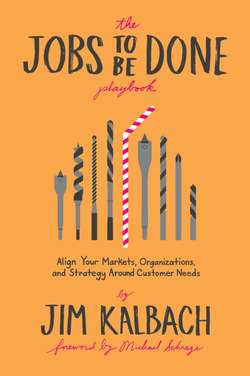Читать книгу The Jobs To Be Done Playbook - Jim Kalbach - Страница 21
На сайте Литреса книга снята с продажи.
Job Performer
ОглавлениеWho is trying to get the job done? The job performer represents the individual who will be executing the job. That person is the eventual end user of the services you’ll provide.
Be sure to make a distinction between the various functions involved in performing the job, in particular differentiating the performer from the buyer. Don’t conflate the two, because they have different needs. Think about two separate hats that are worn: one is for the job performer while carrying out the job; the other is for the buyer when purchasing a product or service.
Now, in B2C contexts, a single person may switch between the two hats. But their needs while wearing each hat are distinct. In the B2B situations, the job performer and the buyer are often separate people. For instance, a procurement office may purchase equipment and materials for others in the company without their direct input.
In addition to the job performer and the buyer, other functions within the job ecosystem to consider include the following:
• Approver: Someone who authorizes the acquisition of a solution, e.g., a controller, a spouse or parent, or a budget holder
• Reviewer: Someone who examines a solution for appropriateness, e.g., a lawyer, a consultant, or a compliance officer
• Technician: The person who integrates a solution and gets it working, e.g., an IT support, an installer, or a tech-savvy friend
• Manager: Someone who oversees a job performer while performing the job, e.g., a supervisor, a team lead, or a boss
• Audience: People who consume the output of performing the job, e.g., a client, a downstream decision-maker, or a team
• Assistant: A person who aids and supports the job performer in getting the job done, e.g., a helper, a teammate, or a friend
Map out the different actors who may be involved in a simple diagram, such as the one shown in Figure 2.3.
FIGURE 2.3 Keep the possible functions in a job ecosystem separate and focus on the job performer first.
Note that these different roles don’t refer to job titles. Instead, they represent different functional actors within the context of getting a job done. To reiterate, consider these as separate roles or hats to wear. The primary focus on attention is on the job performer first. Later, you can consider the needs of the other roles in relation to the job to be done and the job performer.
For instance, let’s say your company provides an online task management tool to enterprises. The job performer is the ultimate end user, perhaps a programmer on a development team. The buyer could be the collaboration software manager of the customer’s company, for example, who may need to get approval from a procurement office and have the legal department review any software agreement. The job performer also has a manager, who determines the practices around assigning tasks. Program managers may be the audience of the job performer when she presents progress to them.
Draw a quick map, like the one in Figure 2.3, to help differentiate the job performer from other roles. The JTBD perspective gives a sequence in which to address the needs of various stakeholders: start with the needs of the job performer; then focus on the buyer before looking at the needs of others. Keep in mind this doesn’t mean that buyer needs are unimportant. Instead, solutions must first and foremost address the needs of the job performer ahead of considering the needs of the purchaser.
